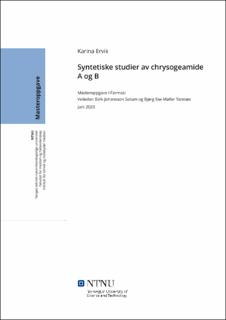| dc.contributor.advisor | Solum, Eirik Johansson | |
| dc.contributor.advisor | Tannæs, Bjørg Siw Møller | |
| dc.contributor.author | Ervik, Karina | |
| dc.date.accessioned | 2021-09-25T16:33:57Z | |
| dc.date.available | 2021-09-25T16:33:57Z | |
| dc.date.issued | 2020 | |
| dc.identifier | no.ntnu:inspera:57707121:39231957 | |
| dc.identifier.uri | https://hdl.handle.net/11250/2783277 | |
| dc.description.abstract | En av de største utfordringene i dagens samfunn er utviklingen av antibiotikaresistens hos bakterier. For å forhindre at bakterielle infeksjoner blir like dødelig som før oppdagelsen av antibiotika er det helt avgjørende å utvikle nye typer antibiotika samtidig som bakterienes resistensmekanismer hemmes. Naturstoffer har tidligere vist seg å være viktig i utviklingen av nye antibiotika. Oppdagelse, identifisering, og testing av nye naturstoffer forskes derfor mye på. Målet for denne masteroppgaven var å syntetisere to nylig identifiserte naturstoffer fra den marine soppen Penicillin chrysogenum CHNSCLM-0003, chrysogeamide A og B. Det var ønskelig å teste disse forbindelsene på et bredt spekter av bakterier for å undersøke eventuell antibakteriell effekt.
Syntesen av målmolekylene besto av blant annet peptidsyntese av et pentapeptid, Negishi krysskobling, samt asymmetrisk syntese. Syntese av dipeptider ga høye utbytter, og det ble utarbeidet en prosedyre som ga kortere reaksjonstid og enklere opparbeidelse enn publisert i litteraturprosedyrer. Peptidsyntese av tetrapeptid og pentapeptid derimot viste seg å være utfordrende når det kom til rensing av produktet. Etter prøving og feiling ble det utviklet en metode som gjorde isolering av produktet enklere. Istedenfor å benytte standard koblingsreagenser EDC, HOBt og DIPEA ble kun EDC og DIPEA benyttet.
Negishi krysskobling med Pd-PEPPSI-IPr viste seg å være en utfordring da sidereaksjoner som -hydrid eliminering og homokobling var eneste produkter etter reaksjon. Variasjon i temperatur og mengde katalysator ga ingen endringer av resultatet. En alternativ syntesestrategi ble forsøkt for å syntetisere målmolekylene uten Negishi krysskobling. En sentral del av den nye strategien var asymmetrisk alkylering. Asymmetrisk alkylering har tidligere vist god stereoselektivitet, men reaksjonen ga ikke produkt. Videre tester viste også vanskeligheter med aminolyse som skulle koble pentapeptidet sammen med ikke-peptidfragmentene. Syntese av chrysogeamide A og B ble ikke fullført, og det gjenstår enda arbeid for å utvikle en syntesestrategi for forbindelsene. | |
| dc.description.abstract | One of the greatest challenges the world is facing today is the development of bacteria that are resistant to antibiotics. To avoid bacterial infections becoming as deadly as they were before the discovery of antibiotics, it is crucial to develop new antibiotics and to stop the resistance mechanism in bacteria. Natural products have played a central role in the development of new antibiotics, and much of recent research has focused on the discovery, identification and testing of new natural products. The aim of this master thesis was to synthesize two newly identified natural products from the marine fungus Penicillin chrysogenum CHNSCLM-0003, chrysogeamide A and B. These compounds would then be tested on a wide range of bacteria in order to assess their antibiotic properties.
The synthesis of the target compounds consisted mainly of peptide synthesis, Negishi cross coupling and asymmetrical synthesis. Synthesis of dipeptides gave a high yield, which inspired the design of a procedure that shortened reaction time and simplified purification processes in comparison to methods shown in literature. The peptide synthesis of tetra- and pentapeptides proved to be challenging during the purification process, making isolating the product difficult. After a process of trial-and-error, it became evident that the reaction gave the best results without using the reagent HOBt, making it possible to isolate the product.
Negishi cross coupling using the Pd-PEPPSI-IPr complex only gave -hydride elimination and homocoupled products. A variation in temperature or quantity of catalyst did not change this outcome, making the cross coupling a challenge. An alternative synthesis plan was therefore tried without the Negishi cross coupling. In the new plan, asymmetrical alkylation played an important role. Asymmetric alkylation would selectively give the chiral center needed, but the reaction failed. Further testing also revealed challenges with aminolyses connecting the peptide with the non-peptide fragment. Synthesis of chrysogeamide A and B was unsuccessful, making further research necessary in order to properly synthesize these compounds. | |
| dc.language | | |
| dc.publisher | NTNU | |
| dc.title | Syntetiske studier av chrysogeamide A og B | |
| dc.type | Master thesis | |
